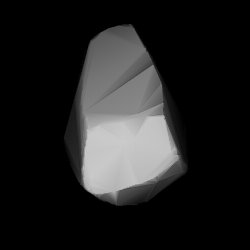
Lumen is a carbonaceous asteroid from the intermediate asteroid belt, approximately 130 kilometers in diameter. It is an identified Eunomian interloper.
827 Wolfiana, provisional designation 1916 ZW, is a Florian asteroid from the inner regions of the asteroid belt, approximately 8 kilometers in diameter. It was discovered at Vienna Observatory on 29 August 1916, by Austrian astronomer Johann Palisa, who named it after German astronomer Max Wolf. The assumed stony asteroid has a rotation period of 4.0654 hours.
1141 Bohmia, provisional designation 1930 AA, is a Florian asteroid from the inner regions of the asteroid belt, approximately 6 kilometers in diameter. It was discovered by German astronomer Max Wolf at the Heidelberg-Königstuhl State Observatory on 4 January 1930. The asteroid was named after German philanthropist Katharina Bohm-Waltz.
1047 Geisha, provisional designation 1924 TE, is a stony Florian asteroid from the inner regions of the asteroid belt, approximately 11 kilometers in diameter. It was discovered on 17 November 1924, by German astronomer Karl Reinmuth at the Heidelberg-Königstuhl State Observatory in southwest Germany. The asteroid was named after the British musical The Geisha.
2751 Campbell, provisional designation 1962 RP, is a stony Nysian asteroid from the inner regions of the asteroid belt, approximately 6 kilometers in diameter.
3181 Ahnert, provisional designation 1964 EC, is a stony Flora asteroid from the inner regions of the asteroid belt, about 8 kilometers in diameter. It was discovered by German astronomer Freimut Börngen at the Karl Schwarzschild Observatory in Tautenburg, eastern Germany, on 8 March 1964.
3771 Alexejtolstoj (provisional designation 1974 SB3) is a stony Flora asteroid from the inner regions of the asteroid belt, approximately 3.7 kilometers in diameter. It was discovered on 20 September 1974, by Russian–Ukrainian astronomer Lyudmila Zhuravleva at the Crimean Astrophysical Observatory in Nauchnyj on the Crimean peninsula. The asteroid was named after writer Aleksey Nikolayevich Tolstoy.
5951 Alicemonet, provisional designation 1986 TZ1, is a stony Flora asteroid approximately 6 kilometres in diameter from the inner regions of the asteroid belt. It was discovered on 7 October 1986, by American astronomer Edward Bowell at Anderson Mesa Station of the Lowell Observatory in Flagstaff, Arizona. The asteroid was named after American astronomer Alice Monet.
2873 Binzel, provisional designation 1982 FR, is a stony Florian asteroid and binary system from the inner regions of the asteroid belt, approximately 6.5 kilometers in diameter. It was discovered on 28 March 1982, by American astronomer Edward Bowell at the Anderson Mesa Station in Flagstaff, Arizona. The asteroid was named after astronomer Richard Binzel. Its 1.6-kilometer minor-planet moon was discovered in 2019.

1335 Demoulina, provisional designation 1934 RE, is a stony Florian asteroid from the inner regions of the asteroid belt, approximately 7 kilometers in diameter. Discovered by Karl Reinmuth at Heidelberg Observatory in 1934, the asteroid was named after Prof. Demoulin, a Belgian astronomer at Ghent University. It has a slower-than average spin rate of nearly 75 hours.
1370 Hella, provisional designation 1935 QG, is a stony Florian asteroid from the inner regions of the asteroid belt, approximately 5.4 kilometers in diameter. It was discovered on 31 August 1935, by astronomer Karl Reinmuth at the Heidelberg-Königstuhl State Observatory in southwest Germany. The asteroid was named for Helene Nowacki, an astronomer at the Astronomical Calculation Institute.
2028 Janequeo, provisional designation 1968 OB1, is a stony Florian asteroid from the inner regions of the asteroid belt, approximately 3 kilometers in diameter. It was discovered on July 18, 1968, by Chilean astronomers Carlos Torres and S. Cofre at the Cerro El Roble Station of Chile's National Astronomical Observatory. The asteroid named after the indigenous heroine Janequeo (Yanequén).
9223 Leifandersson, provisional designation 1995 YY7, is a background asteroid from the inner regions of the asteroid belt, approximately 4.5 kilometers in diameter. It was discovered on 18 December 1995, by astronomers of the Spacewatch program at Kitt Peak National Observatory in Arizona, United States. The asteroid was named in memory of Swedish astronomer Leif Erland Andersson. The assumed stony asteroid has a rotation period of 3.758 hours.
2004 Lexell, provisional designation 1973 SV2, is a stony Florian asteroid from the inner regions of the asteroid belt, approximately 7.5 kilometers in diameter. The asteroid was discovered on 22 September 1973, by Soviet astronomer Nikolai Chernykh at the Crimean Astrophysical Observatory in Nauchnij, on the Crimean peninsula, and later named for Swedish-Russian astronomer and mathematician Anders Johan Lexell.
1739 Meyermann, provisional designation 1939 PF, is a stony Florian asteroid from the inner regions of the asteroid belt, approximately 7.5 kilometers in diameter. It was discovered by German astronomer Karl Reinmuth at Heidelberg Observatory on 15 August 1939. It was later named in memory of astronomer Bruno Meyermann.
11118 Modra, provisional designation 1996 PK, is a Flora asteroid of uncertain composition from the inner regions of the asteroid belt, approximately 5 kilometers in diameter.
1195 Orangia, provisional designation 1931 KD, is a stony Florian asteroid from the inner regions of the asteroid belt, approximately 6 kilometers in diameter. It was discovered on 24 May 1931, by South African astronomer Cyril Jackson at the Union Observatory in Johannesburg, South Africa. It was named after the Orange Free State Province.
2513 Baetslé, provisional designation 1950 SH, is a stony Flora asteroid from the inner regions of the asteroid belt, approximately 16 kilometers in diameter.
1513 Mátra, provisional designation 1940 EB, is a stony Florian asteroid from the inner regions of the asteroid belt, approximately 5 kilometers in diameter. It was discovered on 10 March 1940, by Hungarian astronomer György Kulin at Konkoly Observatory in Budapest, Hungary. It was later named after the Mátra mountain range.
1530 Rantaseppä, provisional designation 1938 SG, is a stony Florian asteroid from the inner regions of the asteroid belt, approximately 5 kilometers in diameter. Discovered by Yrjö Väisälä at Turku Observatory in 1938, it was later named after Finnish astronomer Hilkka Rantaseppä-Helenius.


